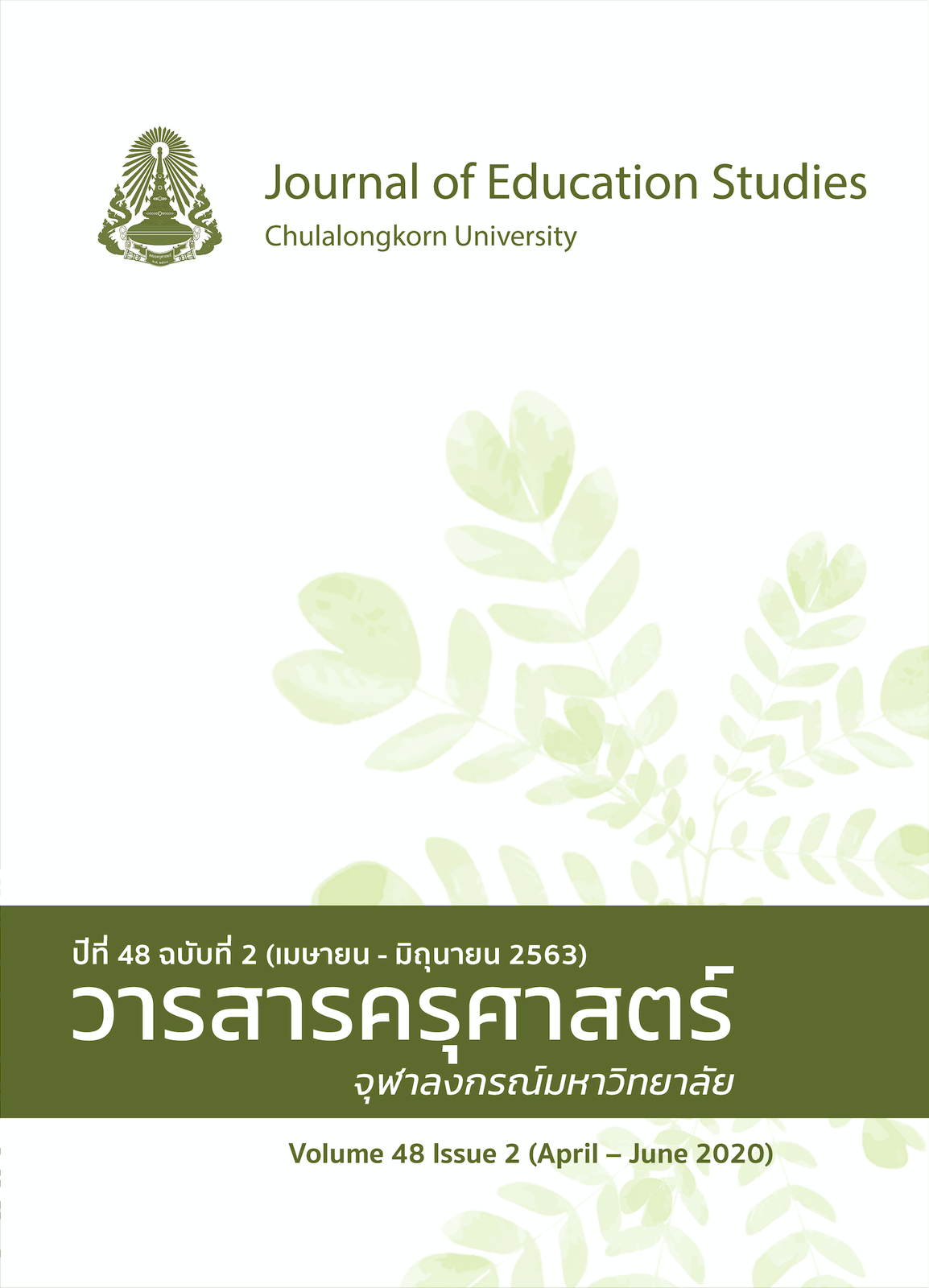รูปแบบการจัดการเทคโนโลยีสารสนเทศด้านการเรียนการสอนเพื่อพัฒนาคุณภาพการศึกษาของโรงเรียนประถมศึกษาขนาดเล็กในเขตปริมณฑลของกรุงเทพมหานคร
คำสำคัญ:
การจัดการเทคโนโลยีสารสนเทศ, การพัฒนาคุณภาพการศึกษา, โรงเรียนประถมศึกษาขนาดเล็กบทคัดย่อ
งานวิจัยนี้มีวัตถุประสงค์เพื่อ 1) ศึกษาสภาพปัจจุบันของการจัดการเทคโนโลยีสารสนเทศด้านการเรียนการสอนฯ 2) สร้างรูปแบบการจัดการเทคโนโลยีสารสนเทศด้านการเรียนการสอนฯ และ 3) ประเมินรูปแบบการจัดการเทคโนโลยีสารสนเทศด้านการเรียนการสอนฯ กลุ่มเป้าหมาย ได้แก่ ผู้บริหารและบุคลากรโรงเรียนประถมศึกษาขนาดเล็กในเขตปริมณฑลของกรุงเทพฯ จำนวน 105 แห่ง แห่งละ 3 คน รวมทั้งสิ้น 315 คน เครื่องมือที่ใช้ ได้แก่ แบบสอบถาม แบบสัมภาษณ์เชิงลึก และแบบประเมินรูปแบบการจัดการเทคโนโลยีสารสนเทศด้านการเรียนการสอนเพื่อพัฒนาคุณภาพการศึกษา วิเคราะห์ข้อมูลโดยการหาค่าเฉลี่ย ส่วนเบี่ยงเบนมาตรฐาน และการวิเคราะห์เนื้อหา
ผลการวิจัย พบว่า 1) สภาพปัจจุบันของการจัดการเทคโนโลยีสารสนเทศด้านการเรียนการสอนฯ มี 4 องค์ประกอบหลัก ได้แก่ (1) การบริหารสถานศึกษา (2) การจัดการเทคโนโลยีสารสนเทศด้านการเรียนการสอน (3) ปัจจัยส่งเสริมคุณภาพการศึกษา และ (4) คุณภาพการศึกษาของโรงเรียน 2) รูปแบบการจัดการเทคโนโลยีสารสนเทศด้านการเรียนการสอนฯ เป็นชุดของการกำหนดจุดเน้น วัตถุประสงค์ กระบวนการ และวิธีการ ตามโครงสร้างของการบริหารการจัดการ ปัจจัยส่งเสริมคุณภาพการศึกษา และคุณภาพการศึกษาของโรงเรียน และ 3) รูปแบบการจัดการเทคโนโลยีสารสนเทศด้านการเรียนการสอนฯ มีความเหมาะสม และความเป็นไปได้ อยู่ในระดับมากที่สุด และข้อมูลมีการกระจายตัวน้อย
เอกสารอ้างอิง
กระทรวงศึกษาธิการ. (2560). กรอบทิศทางแผนการศึกษาแห่งชาติ พ.ศ. 2560–2574. สำนักงานเลขาธิการสภาการศึกษา.
จรูญ จับบัง. (2554). รูปแบบการพัฒนาคุณภาพการศึกษาตามยุทธศาสตร์การพัฒนาโรงเรียนขนาดเล็กด้วยกระบวนการวิจัยเชิงปฏิบัติการแบบมีส่วนร่วม สังกัดสำนักงานคณะกรรมการการศึกษาขั้นพื้นฐาน [วิทยานิพนธ์ปริญญาดุษฎีบัณฑิต]. มหาวิทยาลัยบูรพา.
จารุวรรณ นาตัน. (2556). นวัตกรรมการบริหารโรงเรียนประถมศึกษาขนาดเล็ก. วารสารวิชาการ Veridian E-Journal, 6(3), 729-743. https://he02.tci-thaijo.org/index.php/Veridian-E-Journal/article/view/31522/27070
ฐิตารีย์ วิลัยเลิศ. (2554). รูปแบบการจัดการเทคโนโลยีสารสนเทศและการสื่อสารของโรงเรียนในฝัน จังหวัดกาฬสินธุ์ [วิทยานิพนธ์ปริญญาดุษฎีบัณฑิต ไม่ได้ตีพิมพ์]. มหาวิทยาลัยราชภัฎมหาสารคาม.
พรพัสนันท์ พรพุทธิชัย (2554). สภาพการใช้เทคโนโลยีสารสนเทศเพื่อการบริหารของสถานศึกษาขั้นพื้นฐาน ในสังกัดสำนักงานเขตพื้นที่การศึกษาประถมศึกษาสุโขทัย เขต 2 [วิทยานิพนธ์ปริญญามหาบัณฑิต ไม่ได้ตีพิมพ์]. มหาวิทยาลัยสุโขทัยธรรมาธิราช.
สำนักงานคณะกรรมการการศึกษาขั้นพื้นฐาน. (2556). การบริหารจัดการโรงเรียนขนาดเล็กให้มีประสิทธิภาพ. สำนักงานคณะกรรมการการศึกษาขั้นพื้นฐาน กระทรวงศึกษาธิการ. http://www.obec.go.th/news/36415
สำนักงานเลขาธิการสภาการศึกษา. (2556). รายงานการวิจัยและพัฒนารูปแบบการพัฒนาครูและผู้บริหารสถานศึกษาแบบใช้โรงเรียนเป็นฐานในโรงเรียนขนาดเล็ก ระยะที่ 2 (ฉบับสรุป). พริกหวานกราฟิก.
สุขุม เฉลยทรัพย์. (2555). เทคโนโลยีสารสนเทศ. คณะมนุษยศาสตร์และสังคมศาสตร์. มหาวิทยาลัยราชภัฏสวนดุสิต.
ภาษาอังกฤษ
Armstrong., M. (2006). Management processes and functions (10th ed.). Kogan Page. ISBN 0-7494-4631-5
Bateman, T. S., & Scott, A. S. (1999). Management: Building competitive advantage (4th ed.). McGraw-Hill.
Brown, W. B., & Moberg, D. J. (1980). Organization theory and management: Amacro approach. John Wiley and Sons.
Deming, E. (2006). Deming cycle development. International Monetary Fund.
Husen, T., & Postlethwaite, N. T. (1994). The international encyclopedia of education (2nd ed.). Pergawon.




